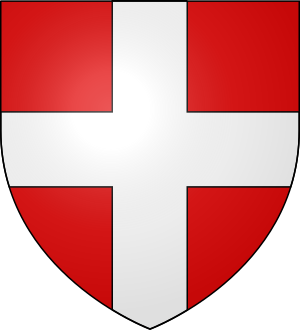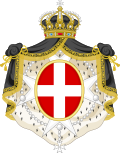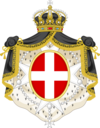قائمة الأساتذة الكبار للفرسان الإسبتارية

Coat of arms of the Order of Saint John. The personal coat of arms of the Grand Master would be shown alongside the order's coat of arms in 14th to 15th centuries. Beginning in the mid-15th century, the Grand Master would quarter the order's coat of arms with his own.
هذه قائمة بأسماء كبار فرسان الإسبتارية ، بما في ذلك استمرارها باعتبارها منظمة فرسان مالطة العسكرية المستقلة بعد عام 1798. وتتضمن أيضًا "مناهضي الماجستير الكبار" غير المعترف بهم والملازمين أو القائمين أثناء الوظائف الشاغرة.
فرسان الإسبتارية (مملكة القدس)
| Nr | Title | Picture | Name | Time in office | Notes |
|---|---|---|---|---|---|
| —/1 | Founder and Rector of the Hospital | 
|
Blessed Gerard | 1099/1113–1118/20 | Order established in 1099 and given papal recognition in 1113 by Paschal II |
| 1/2 | Custos[1] | 
|
Raymond du Puy | 1118/21/23–1160 | |
| 2/3 | Custos | 
|
Auger de Balben | 1160–1163 | |
| 3/4 | 
|
Arnaud de Comps | 1162–1163 | Historicity uncertain | |
| 4/5 | Custos | 
|
Gilbert d'Aissailly | 1163–1169 | |
| 5/6 | Gastone de Murols | c. 1169 | |||
| 6/7 | Custos | 
|
Jobert of Syria | c. 1169/72–1177 | Acted as regent for king Manuel I in 1172. In 1174 opposed Miles of Plancy in favour of Raymond III of Tripoli. Fought in the crusade of Philip I, Count of Flanders of 1176. |
| 7/8 | Custos | 
|
Roger de Moulins | 1177–1187 | |
| 8/9 | Provisor[بحاجة لمصدر] | Armengol de Aspa (Ermengard d'Aps) | 1187–1190 | Loss of Jerusalem in 1187, headquarters moved to Acre. In the crisis following the loss of Jerusalem, Ermengard was not elected as custos and acted only ad interim. He was nevertheless included into the canonical list of Grand Masters compiled in the early modern period. After the capture of Acre and the consolidation of the order, Ermengard retired with the regular election of Garnier de Nablus as new master. | |
| 9/10 | Custos | 
|
Garnier de Nablus | 1190–1192 | Battle of Arsuf 1191 |
| 10/11 | Custos | 
|
Geoffroy de Donjon | 1193–1202 | |
| 11/12 | Custos | 
|
Afonso de Portugal | 1202–1206 | Fourth Crusade, resigned in 1206 |
| 12/13 | Custos | 
|
Geoffrey le Rat (Gothofredus Mus) | 1206–1207 | First structured the order by nationality, or langues. |
| 13/14 | Custos | 
|
Guérin de Montaigu | 1207–1228 | Fifth Crusade, Siege of Damietta (1218–1219) |
| 14/15 | Custos | 
|
Bertrand de Thercy | 1228–1231 | Re-conquest of Jerusalem in 1228/9 |
| 15/16 | Custos | Guerin Lebrun | 1231–1236 | Captured in battle, and died in captivity in Egypt | |
| 16/17 | Custos | Bertrand de Comps | 1236–1240 | Headquarters moved to Jerusalem | |
| 17/18 | Custos | 
|
Pierre de Vieille-Brioude | 1240–1242 | |
| 18/19 | Custos | 
|
Guillaume de Chateauneuf | 1242–1258 | Fall of Jerusalem in 1244, headquarters at Acre, Krak des Chevaliers and Margat |
| 19/20 | Custos | 
|
Hugues de Revel | 1258–1277 | |
| 20/21 | 
|
Nicolas Lorgne | 1277–1285 | Loss of Margat 1285 | |
| 21/22 | 
|
Jean de Villiers | 1285–1294 | Siege of Acre (1291) | |
| 22/23 | Odon de Pins | 1294–1296 | Headquarters moved to Limisso, Cyprus | ||
| 23/24 | 
|
Guillaume de Villaret | 1296–1305 |
فرسان رودس
| Nr | Title | Picture | Name | Time in office | Notes |
|---|---|---|---|---|---|
| 24/25 | Magister | 
|
Foulques de Villaret | 1305–1319 | Nephew of Guillaume de Villaret. Hospitaller conquest of Rhodes in 1308/9. |
| Anti-Grand Master | Maurice de Pagnac (unrecognized) |
1317–1319 | |||
| 25/26 | Magister | 
|
Hélion de Villeneuve | 1319–1346 | |
| 26/27 | Magister | 
|
Dieudonné de Gozon | 1346–1353 | |
| 27/28 | Magister | 
|
Pierre de Corneillan | 1353–1355 | |
| 28/29 | Magister | 
|
Roger de Pins | 1355–1365 | |
| 29/30 | Magister | 
|
Raymond Berengar | 1365–1374 | |
| 20/31 | Magister | 
|
Robert de Juilly (de Juliac) | 1374–1376 | |
| 31/32 | Magister | 
|
Juan Fernández de Heredia | 1376–1396 | |
| (32/33) | Magister | 
|
Riccardo Caracciolo | 1383–1395 | Rival Grand Master, recognized only by the Langues of Italy and England.[2] |
| 33/34 | Magister | 
|
Philibert de Naillac | 1396–1421 | |
| 34/35 | Magister | 
|
Anton Flavian de Ripa | 1421–1437 | |
| 35/36 | Grandis Magister | 
|
Jean de Lastic | 1437–1454 | Siege of Rhodes (1444) |
| 36/37 | Grandis Magister | 
|
Jacques de Milly | 1454–1461 | |
| 37/38 | Grandis Magister | 
|
Piero Raimondo Zacosta | 1461–1467 | |
| 38/39 | Grandis Magister | 
|
Giovanni Battista Orsini | 1467–1476 | |
| 39/40 | Grandis Magister | 
|
Pierre d'Aubusson | 1476–1503 | Siege of Rhodes (1480) |
| 40/41 | Magnus Magister | 
|
Emery d'Amboise | 1503–1512 | |
| 41/42 | Magnus Magister | 
|
Guy de Blanchefort | 1512–1513 | |
| 42/43 | Magnus Magister | 
|
Fabrizio del Carretto | 1513–1521 |
فرسان مالطة
| Nr | Title | Picture | Name | Time in office | Notes |
|---|---|---|---|---|---|
| 43/44 | Magister | 
|
Philippe Villiers de L'Isle-Adam | 1521–1534 | Siege of Rhodes (1522), headquarters moved to Malta in 1530 |
| 44/45 | Magister | 
|
Piero de Ponte | 1534–1535 | |
| 45/46 | Magister | 
|
Didier de Saint-Jaille | 1535–1536 | |
| 46/47 | Magister | 
|
Juan de Homedes | 1536–1553 | Malta was attacked by an Ottoman fleet in 1551. The attack was repelled, but the Ottomans captured the island of Gozo, and later also the order's stronghold in Tripoli. De Homedes began a program improve the fortifications at Malta |
| 47/48 | Magister | 
|
Claude de la Sengle | 1553–1557 | Continued the improvement of fortifications, expanding Fort Saint Michael into a major bastion and completing Fort Saint Elmo. |
| 48/49 | Magister | 
|
Jean Parisot de Valette | 1557–1568 | Valette became the Order's most illustrious leader, commanding the resistance against the Ottomans at the Great Siege of Malta in 1565. |
| 49/50 | Magister | 
|
Pierre de Monte | 1568–1572 | Continued the construction of the new capital Valletta. Strengthened the order's fleet, and participated in the Battle of Lepanto of 7 October 1571. |
| 50/51 | Magister | 
|
Jean de la Cassière | 1572–1581 | Crisis in the wake of the Protestant Reformation. Expulsion of the Order of Saint John (Bailiwick of Brandenburg) in 1581. |
| Lieutenant | Mathurin Romegas | 1577–1581 | |||
| Anti-Grand Master | Mathurin Romegas | 1581 | |||
| 51/52 | Magister | 
|
Hugues Loubenx de Verdalle | 1581–1595 | |
| 52/53 | Magister | 
|
Martín Garzés | 1595–1601 | |
| 53/54 | Magister | 
|
Alof de Wignacourt | 1601–1622 | Constructed the Wignacourt towers and the Wignacourt Aqueduct. Repelled the last serious Ottoman attempt at capturing Malta in 1614. |
| 54/55 | Magister | 
|
Luís Mendes de Vasconcellos | 1622–1623 | |
| 55/56 | Magister Magnus | 
|
Antoine de Paule | 1623–1636 | |
| 56/57 | Magister Magnus | 
|
Giovanni Paolo Lascaris | 1636–1657 | Caribbean possessions |
| 57/58 | Magister Magnus | 
|
Martin de Redin | 1657–1660 | |
| 58/59 | Magister Magnus | 
|
Annet de Clermont-Gessant | 1660 | Died less than four months after his election, on 2 June 1660. |
| 59/60 | Magister Magnus | 
|
Rafael Cotoner | 1660–1663 | Commissioned the Italian Baroque artist Mattia Preti to start painting Saint John's Co-Cathedral in Valletta. |
| 60/61 | Magister Magnus | 
|
Nicolás Cotoner | 1663–1680 | Siege of Candia + Mattia Preti's work at St John's Co-Cathedral completed. |
| 61/62 | Magister Magnus | 
|
Gregorio Carafa | 1680–1690 | Renovation of Auberge d'Italie in the Baroque style, improvement of Fort Saint Angelo and Fort Saint Elmo. Ottoman attacks were still expected, but there were no longer any notable engagements. |
| 62/63 | Magister Magnus | 
|
Adrien de Wignacourt | 1690–1697 | Instituted a widows pension for the widows of those fallen in the Ottoman wars. |
| 63/64 | Magister Magnus | 
|
Ramón Perellós | 1697–1720 | Organised the Consulato del Mare (Consulate of the Sea). Established relations with imperial Russia. Fought corruption within the Order. Engagement against Ottoman pirates. |
| 64/65 | Magister Magnus | 
|
Marc'Antonio Zondadari | 1720–1722 | |
| 65/66 | Magister Magnus | 
|
António Manoel de Vilhena | 1722–1736 | Restored the city Mdina, constructed Fort Manoel and significantly improved the fortifications of Malta in general. Built Casa Leoni and Palazzo Parisio, and renovated Verdala Palace. Manoel Theatre (1731). Conducted peace negotiations with the Ottomans, without result. Declared neutrality in the War of the Polish Succession. |
| 66/67 | Magister Magnus | 
|
Ramón Despuig | 1736–1741 | Improved the fortifications of Mdina, modernised legislation, renovated the Co-Cathedral of St. John. Naval engagements with Ottoman Algeria. |
| 67/68 | Magister Magnus | 
|
Manuel Pinto da Fonseca | 1741–1773 | Expelled the Jesuits from Malta. In 1753 proclaimed the sovereignty of the Order on Malta and a dispute started with the Kingdom of Sicily under King Charles V. Normal relations were resumed the next year, with the Order retaining de facto control over Malta as a sovereign state.[3] |
| 68/69 | Magister Magnus | 
|
Francisco Ximénez de Tejada | 1773–1775 | Rising of the Priests (1775), bankruptcy of the order. |
| 69/70 | Magister Magnus | 
|
Emmanuel de Rohan-Polduc | 1775–1797 | Instituted the Anglo-Bavarian langue and the Russian Grand Priory. |
| 70/71 | Magister Magnus | 
|
Ferdinand von Hompesch zu Bolheim |
1797–1799 | First German elected to the Office. Abdicated 6 July 1799 following the French invasion of Malta. |
منظمة فرسان مالطة العسكرية المستقلة
| Prince and Grand Master the Sovereign Military Order of Malta | |
|---|---|
 | |
| الحالي | |
| Ruy Gonçalo do Valle Peixoto de Villas Boas Lieutenant ad interim since 29 أبريل 2020 | |
| التفاصيل | |
| الأسلوب | His Most Eminent Highness |
| أول عاهل | Gerard Thom Giovanni Battista Ceschi a Santa Croce |
| التشكيل | 1099/1879 |
قالب:Catholic Church hierarchy sidebar
| Nr | Title | Picture | Name | Time in office | Notes |
|---|---|---|---|---|---|
| 72[4] | Grand Master (partial recognition) | 
|
Paul I of Russia | 1798–1801 | Elected by the Priory of St. Petersburg in September 1798 (before the abdication of von Hompesch). This election resulted in the establishment of the Russian tradition of the Knights Hospitaller. On Paul's death in 1801, his son Alexander I of Russia decided to end this irregular situation and refused to be Grand Master. The election of a new Grand Master was deferred to pope Pius VII. |

|
Nikolay Saltykov | 1801–1803 | De facto Lieutenant in Saint Petersburg | ||
| 73[4] | Grand Master Gran Maestro |

|
Giovanni Battista Tommasi | 1803–1805 | Appointed by Pope Pius VII in 1803. Residence in Messina and Catania |
| Lieutenant Luogotenente Generale |

|
Innico Maria Guevara-Suardo | 1805–1814 | Headquarters in Catania. Loss of territories and Protestant branches. | |
| Lieutenant Luogotenente Generale |

|
Andrea Di Giovanni y Centellés | 1814–1821 | Headquarters in Catania | |
| Lieutenant Luogotenente Generale |

|
Antoine Busca | 1821–1834 | Headquarters in Ferrara. SMOM recognized at the Congress of Verona (1822). | |
| Lieutenant Luogotenente Generale |

|
Carlo Candida | 1834–1845 | Headquarters moved to Palazzo Malta, Rome. Restoration of the grand priories of Lombardy-Venetia and of Sicily in 1839/41. | |
| Lieutenant Luogotenente Generale |

|
Filippo di Colloredo-Mels | 1845–1864 | ||
| Lieutenant Luogotenente Generale |

|
Alessandro Borgia | 1865–1871 | ||
| Lieutenant Luogotenente Generale |

|
Giovanni Battista Ceschi a Santa Croce |
1871–1879 | ||
| 74[4] | Prince and Grand Master Princeps et Magister Magnus |

|
Giovanni Battista Ceschi a Santa Croce |
1879–1905 | Restoration of the office of Grand Master after a 75-year interregnum, confirmed by Pope Leo XIII. |
| 75[4] | Prince and Grand Master Princeps et Magister Magnus |

|
Galeas von Thun und Hohenstein |
1905–1931 | |
| 76[4] | Prince and Grand Master Principe e Gran Maestro |

|
Ludovico Chigi Albani della Rovere |
1931–1951 | |
| Lieutenant Luogotenente Generale |

|
Antonio Hercolani Fava Simonetti |
1951–1955 | ||
| Lieutenant Luogotenente Generale |

|
Ernesto Paternò Castello di Carcaci |
1955–1962 | ||
| 77[4] | Prince and Grand Master Principe e Gran Maestro |

|
Angelo de Mojana di Cologna | 1962–1988 | |
| Lieutenant ad interim | 
|
Jean Charles Pallavicini | 1988 | ||
| 78[4] | Prince and Grand Master Principe e Gran Maestro |

|
Andrew Bertie | 1988–2008 | Partial revision of the constitution (1997, promulgated 1961).[5][6] |
| Lieutenant ad interim | 
|
Giacomo dalla Torre del Tempio di Sanguinetto | 2008 | ||
| 79[4] | Prince and Grand Master Principe e Gran Maestro |

|
Matthew Festing | 2008–2017 | First Grand Master elected under the new constitution of 1997. Resigned in 2017 following a dispute with the Vatican.[7] |
| Lieutenant ad interim | 
|
Ludwig Hoffmann-Rumerstein | 2017 | ||
| Lieutenant Luogotenente Generale |

|
Giacomo dalla Torre del Tempio di Sanguinetto | 2017–2018 | ||
| 80[4] | Prince and Grand Master Principe e Gran Maestro |

|
Giacomo dalla Torre del Tempio di Sanguinetto | 2018–2020 | |
| Lieutenant ad interim | Ruy Gonçalo do Valle Peixoto de Villas Boas | 2020–present |
أنظر أيضًا
- Grand Master (order)
- Order of Saint John (Bailiwick of Brandenburg)#Herrenmeister
- Grand Magistry and Lieutenancies of the Order of the Holy Sepulchre
- Grand Masters of the Teutonic Knights
- Grand Masters of the Order of Saint Lazarus
- Grand Masters of the Knights Templar
- List of heads of state of Malta
المصادر
- ^ The Order's Great Seal, or leaden bulla, remained in use, with some modifications, from the 12th century until 1798. Until 1278, when Nicholas de Lorgne introduced a separate conventual bulla, there was no distinction between the seal of the Grand Master and that of the order. The general design of the seal featured, on the obverse, the Grand Master kneeling in prayer before the patriarchal cross. This image was usually accompanied with the sacred letters alpha and omega, which referenced the Second Coming of Christ. The central image was surrounded by a legend with the Master's name followed by the official designation CVSTOS. Barbara Packard, Seals of the Grand Masters, Museum of the Order of St John, 14 October 2015.
- ^ Morris (1884), p. 61 does not count Caracciolo as numbered Grand Master, giving the number 33 to Philibert de Naillac. A page at orderofmalta.int (as of 2017), the official website of the SMOM, does count Caracciolo as 33rd Grand Master.
- ^ Zammit, Vincent (1992). Il-Gran Mastri - Ġabra ta' Tagħrif dwar l-Istorja ta' Malta fi Żmienhom - It-Tieni Volum 1680-1798. Valletta, Malta: Valletta Publishing & Promotion Co. Ltd. pp. 405–406.
- ^ أ ب ت ث ج ح خ د ذ Numbering according to the SMOM (website orderofmalta.int as of 2017) implies the recognition of Riccardo Caracciolo as 33rd Grand Master, and of Paul I of Russia as 72nd Grand Master (r. 1798–1801).
- ^ Constitutional Charter and Code of the SMOM (1997).
- ^ The sovereign status of the SMOM had been in question as the previous constitution had implied dependence on the Holy See (which had itself been recognized as sovereign in 1922). Approval of the elected Grand Master by the Pope is no longer explicitly required. Bo J. Theutenberg, The Holy See, the Order of Malta and International Law (2003), ISBN 91-974235-6-4
- ^ Pullella, Philip (23 June 2016). "Knights of Malta head resigns after dispute with Vatican". Reuters. Retrieved 25 January 2017.
وصلات خارجية
الكلمات الدالة:
This article may include material from Wikimedia licensed under CC BY-SA 4.0. Please comply with the license terms.

